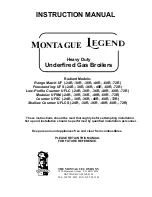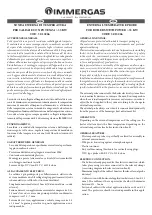
20
ENGLISH
INSTALLER
INSTALLER
Water in central heating systems
INTRODUCTION
Water used in central heating systems MUST be suitably treat-
ed to ensure the correct functioning of those systems and to
guarantee an extended working life for boilers and all other
system components. This applies not only to existing systems
but to newly installed systems too.
Sludge, lime-scale and pollutants present in the water can
cause permanent damage to the heating unit, also within a
short time and regardless of the quality standards of the ma-
terials used.
Contact the Technical Assistance Centre for any further infor-
mation on type and use of additives.
b
Always conform to the standards and legislation applica-
ble in the country of installation.
WATER IN CENTRAL HEATING SYSTEMS.
INSTRUCTIONS FOR THE DESIGN, INSTALLATION AND
MANAGEMENT OF CENTRAL HEATING SYSTEMS.
1. Chemical and physical characteristics of water
The chemical and physical characteristics of water used in
central heating systems must conform to the requirements of
EN 14868 standard and to the following tables:
STEEL BOILERS
with furnace power < 150 kW
Initial filling
water
Regular ser-
vice water (*)
ph
6-8
7,5-9,5
Hardness
°fH
< 10°
< 10°
Electrical
conductivity
μs/cm
< 150
Chlorides
mg/l
< 20
Sulphides
mg/l
< 20
Nitrides
mg/l
< 20
Iron
mg/l
< 0,5
STEEL BOILERS
with furnace power > 150 kW
Initial filling
water
Regular ser-
vice water (*)
ph
6-8
7,5-9,5
Hardness
°fH
< 5°
< 5°
Electrical
conductivity
μs/cm
< 100
Chlorides
mg/l
< 10
Sulphides
mg/l
< 10
Nitrides
mg/l
< 10
Iron
mg/l
< 0,5
(*) values for water in system after 8 weeks of functioning
General note on water used to top up systems:
- If softened water is used to top up a system, 8 weeks
of functioning after topping up, verify that the water in
the system respects the above limits, in particular for
electrical conductivity
- This check is not necessary if demineralised water is
used to top up the system.
2. Central heating systems
b
Do not use automatic filling devices to add water to cen-
tral heating systems. Use a manual device instead and
record top-ups in the system service book.
b
If there are more than one boiler, they must all be put into
service either contemporarily or with a very low rotation
time during the initial period of service, so as to evenly
distribute the limited quantity of initial lime-scale.
b
A flushing cycle must be programmed after the plant has
been installed to flush out any installation debris.
b
Water used to fill a system for the first time and water
used to top it up must always be filtered (using synthetic
or metal mesh filters with a filtration rating of no less than
50 microns) to prevent sludge from forming and trigger-
ing deposit corrosion.
b
The heating system must be flushed out and cleaned
with good workmanship before filling up the existing sys-
tems. The boiler may not be filled until after the heating
system has been flushed out.
2.1 New central heating systems
The system must be filled up slowly the first time; once it is
filled and the air expelled it should never need to be topped
up again.
Systems should also be operated at maximum working tem-
perature the first time they are started up, in order to facilitate
de-aeration. (Gas is not released from the water at low tem-
peratures).
2.2 Reconditioning old central heating systems
If a boiler has to be replaced, do not refill the entire central
heating circuit if the quality of water in it conforms to require-
ments. If the quality of water fails to conform to requirements,
either recondition the old water or separate the water circuits
(water in the boiler circuit must conform to requirements).
3. Corrosion
3.1 Deposit corrosion
Under-deposit corrosion is an electrochemical process, due
to the presence of sand, rust, etc., inside the mass of water.
These solid substances generally deposit on the bottom of the
boiler (sludge), on tube and pipe heads or in the gaps be-
tween pipes and tubes.
Micro-corrosion phenomena may be triggered off owing to the
difference in electrochemical potential coming to be created
between the material in contact with the impurity and the sur-
rounding one.
3.2 Stray current corrosion
Corrosion from stray currents can occur due to the differing
electrical potentials between water in the boiler and the metal-
lic mass of the boiler or piping. This process leaves unmistake-
able traces i.e. small regular conical holes.
b
All metallic parts should be grounded by an efficient
earth cable for this reason.
Содержание THC 1000 GREY
Страница 1: ...THC 150 1450 GREY INSTALLATION OPERATION AND MAINTENANCE MANUAL ...
Страница 37: ...37 ENGLISH TECHNICAL ASSISTANCE CENTRE TECHNICAL ASSISTANCE CENTRE ...
Страница 38: ...38 ENGLISH TECHNICAL ASSISTANCE CENTRE TECHNICAL ASSISTANCE CENTRE ...
Страница 39: ...39 ENGLISH TECHNICAL ASSISTANCE CENTRE TECHNICAL ASSISTANCE CENTRE ...
















































